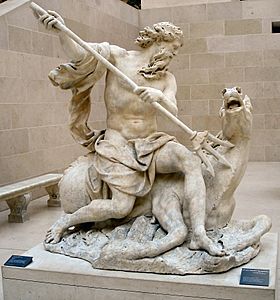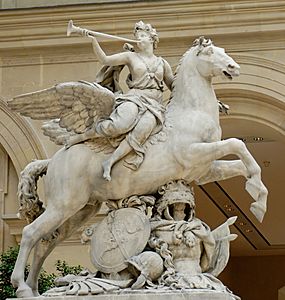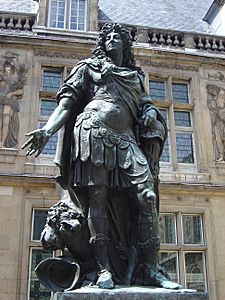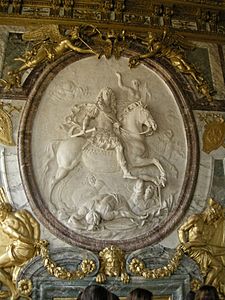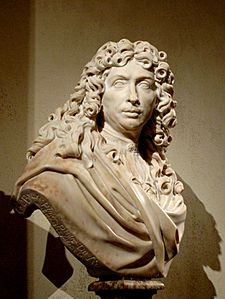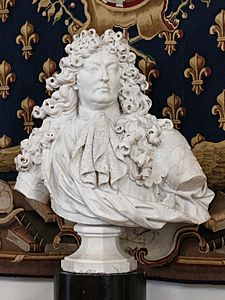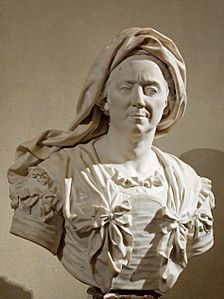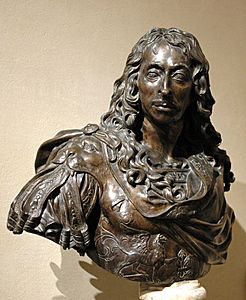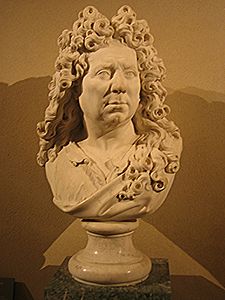Antoine Coysevox facts for kids
Quick facts for kids
Antoine Coysevox
|
|
|---|---|
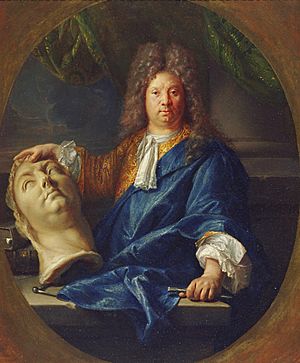
Antoine Coysevox by François Jouvenet (1701)
|
|
| Born | 29 September 1640 Lyon, France
|
| Died | 10 October 1720 (aged 80) Paris, France
|
| Nationality | French |
| Known for | Sculpture |
| Movement | Baroque and Style Louis XIV |
Antoine Coysevox (pronounced quazevo) was a famous French sculptor who lived from 1640 to 1720. He is best known for the amazing sculptures he created for the gardens and inside the Palace of Versailles. He also made many detailed portrait busts, which are sculptures of people's heads and shoulders. His art style was part of the Baroque movement and the Style Louis XIV, which was popular during the reign of King Louis XIV of France.
All About Antoine Coysevox
Coysevox was born in Lyon, France, on September 29, 1640. His father was also a sculptor. His family had moved to France from a region called Franche-Comté, which was controlled by Spain at that time.
Antoine showed his talent early. When he was just seventeen, he created his first sculpture of the Madonna (Mary, the mother of Jesus).
In 1657, Coysevox moved to Paris and started working in the studio of another sculptor named Louis Lerambert. To get even better at his craft, he copied famous Roman sculptures in marble. These included the Venus de Medici and the Castor and Pollux.
In 1667, he was asked by Cardinal Fürstenberg, the bishop of Strasbourg, to create statues for his grand château (a large French country house) in Saverne.
After working at Saverne for four years, Coysevox returned to Paris in 1671. In 1676, he created a sculpture of the king's painter, Charles Le Brun. This work was so good that it helped him get accepted into the Académie Royale. This was a very important art school and institution in France.
Coysevox then joined a special team of artists, including sculptors, painters, and decorators. This team was led by Charles Le Brun. Between 1677 and 1685, they worked together to decorate the magnificent Palace of Versailles and its gardens. Later, from 1701 to 1709, he also created several artworks for the new Château de Marly. This was a smaller palace where King Louis XIV could relax away from the busy life at Versailles.
Coysevox became more and more important in the art world. He became a professor at the Royal Academy in 1678. Then, in 1702, he became its director. This was a very important job, and it meant he helped train many young French sculptors. His nephews, Nicolas Coustou and Guillaume Coustou the Elder, were among his students. They later became famous sculptors themselves.
Antoine Coysevox passed away in Paris on October 10, 1720, at the age of 80.
Grand Sculptures and Statues
A lot of Coysevox's most famous work can be found at the Palace of Versailles. One of his most well-known pieces there is a large stucco (a type of plaster) medallion of King Louis XIV. This sculpture is in the Salon of War inside the Palace. It shows the King as a Roman Emperor on horseback, stepping over his defeated enemies. He looks like a modern Caesar, looking towards the future, while a figure representing Victory offers him a crown made of laurel leaves.
At Versailles, he also sculpted figures like Justice and Force, and a statue representing the River Garonne.
For the Château de Marly, he created several important works. These include the Mercury and the equestrian (on horseback) Fame (made in 1702). He also made four groups of sculptures for the "river" in the château's park. These were La Seine, La Marne, Neptune, and Amphitrite. The first versions were made of stucco in 1699, and then replaced with marble versions when they were finished in 1705.
Coysevox also created about a dozen sculptures for tombs. These include the tomb of Colbert (at Saint-Eustache church), Cardinal Mazarin (now in the Louvre Museum), and the painter Le Brun (in the church of Saint-Nicolas-du-Chardonnet).
Between 1708 and 1710, Coysevox made three more sculptures for Marly: a Pan (now in the Louvre), and two female figures, a Flora and a Dryad (now in the Tuileries Gardens).
For the royal chapel of Les Invalides in Paris, he sculpted a bust of Charlemagne. This was placed next to a statue of Louis XI of France by another sculptor. On the upper part of the same chapel, he made a group of statues showing The Cardinal Virtues.
-
Charlemagne, (1706), at Les Invalides in Paris
-
Neptune, from Marly, 1699-1705 (Louvre)
-
Stucco medallion of Louis XIV, Palace of Versailles
Amazing Portrait Busts
Antoine Coysevox was also very skilled at sculpting portrait busts. These are sculptures that show only the head and shoulders of a person. He made busts of many important men and women of his time.
People thought his busts were incredibly accurate. He didn't try to make his subjects look more beautiful than they were. Instead, he used their poses, detailed clothing, and precise features to give them a special sense of importance and dignity.
Some of the famous people he sculpted include King Louis XIV and King Louis XV. He also made busts of important figures like Jean-Baptiste Colbert, Cardinal Mazarin, Louis, Grand Condé, and Maria Theresa of Austria. Other notable subjects were famous architects like André Le Nôtre, and writers like Jean Racine and Jacques Benigne Bossuet.
-
Bust of Charles Le Brun, (1676) (Louvre)
-
Jean-Baptiste Colbert (the Louvre)
-
Marie Serre, mother of Hyacinthe Rigaud (the Louvre) (1706)
-
Louis, Grand Condé (in the Louvre)
See also
 In Spanish: Antoine Coysevox para niños
In Spanish: Antoine Coysevox para niños



